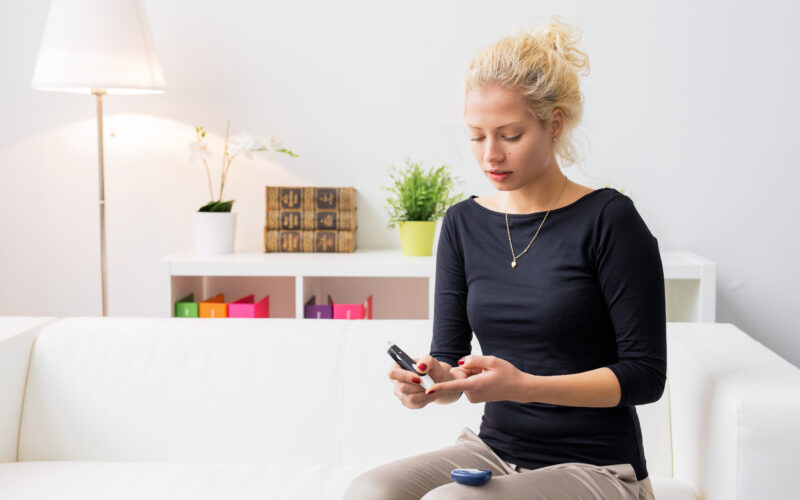Most people familiar with fertility awareness know how charting one’s cycle can help monitor and improve health issues such as PCOS, endometriosis, or infertility. But I learned that Fertility Awareness Methods (FAMs) can help with another health issue altogether—one that isn’t often associated with fertility: Type 1 Diabetes.
It was a long journey with some very dark days that led me to this realization.
Charting for Health
For fifteen years, I have used the SymptoThermal Method to know my fertile window each month. Formerly an active and energetic person, I suddenly became very sick in my early thirties. Not feeling fit was totally new to me. At first, I thought it was a passing chapter and I tried to power through it. But my health deteriorated over weeks and months, and I could not shake it off with resting or stress reduction. I had just moved to a new town where doctors were in short supply, and I was put on a waiting list to see one. At that time, I switched from paper charts to using the sympto app that prompted me to select a cycle goal. For the first time in my life, I set out to chart primarily for “health observation.”
I began documenting the symptoms I was experiencing. My charts showed reduced fertility manifested in delayed and failed ovulation attempts. I blamed this on stress and on excessively low body fat. I had always had a fast metabolism but now I was dealing with severe, inexplicable, and unwanted weight loss. A minimum amount of body fat is required to maintain an estrogen budget large enough to trigger ovulations. Eventually, I stopped producing any fertile signs.
Many other problematic symptoms developed. I was drinking two gallons of water in a 24-hour period without being able to relieve my thirst. My hydration status became a dehydration status. Nausea and digestive upset became constant for me. My breasts disappeared. My mouth became so dry that I had difficulty talking and developed periodontal disease even though I had good oral hygiene, never smoked or skipped a hygienist’s appointment. My hair was falling out. Wounds such as accidental cuts stopped healing and turned into permanent sores. There were no adult pants sizes small enough to fit me. I experienced debilitating muscle spasms in my lower legs and soles of my feet waking me at night. My fertility eventually shut down completely and my charts became one continuous cycle of persistent anovulation, without any estrogen waves.
I went to the nearby busy ER three times in eighteen months with intense nausea but my emaciated appearance caused attending doctors to dismiss me as an anorexic or bulimic hypochondriac, without conducting any tests. My poor oral health supported their theory of bulimia and one nurse told me to “just eat something” while handing me a business card for a psychiatrist. When I showed my current anovulatory fertility chart with my detailed symptoms, she said that I was obsessing, and that “charts were of no medical value.” She then had me take a pregnancy test, the only test she executed, because I was not on birth control pills and had not menstruated in six months. She further recommended I consider hormonal birth control “to regulate my cycle.” Ultimately, I stopped going to the ER because my strength to try and be heard faded.
At my worst, I could not open a car door or stand up without holding on to a support. I had trouble concentrating and felt weak and foggy. I avoided speaking because of my oral pain. I gave in to the fact that I had a mystery illness that was consuming my body and there was nothing I could do about it.
The Turning Point
One day I mustered the energy to see a dentist because the nerve pain in my teeth became unbearable. On his request, I was able to get blood work done that same day, and two hours later I was admitted to the ER with diabetic ketoacidosis, or DKA.
I was diagnosed with Type 1 diabetes during my subsequent 2-week hospital stay. At that point, I knew nothing about Type 1 diabetes, its symptoms or mechanisms. It is the least common type of diabetes and I knew nobody with the disease. I admit that I thought diabetes was always from eating unhealthy or being excessively sedentary. But, in reality, a Type 1 diabetic’s pancreas no longer produces insulin due to an autoimmune attack on its beta cells.
Lack of insulin puts the body in a desperate but unsuccessful state of trying to rid glucose in the blood by attempting to dilute it and flush it out via the kidneys. My body’s lack of insulin forced it into a state of starvation. I learned that energy is unavailable to the cells without insulin allowing it in; I was losing weight so rapidly because my body began breaking down its own tissues for energy, still unavailable for use without insulin. My waking temperatures stayed high throughout because, at this point, my body was additionally dealing with acute pancreatitis and a kidney infection.
I was glad to finally get a diagnosis with the outlook of improvement; nurses encouraged me that lifelong intensive insulin therapy was going to grant me “a new lease on life.” Insulin therapy means administering insulin around the clock to match the body’s needs for moving available energy into cells and to keep homeostasis of nutrients.
I felt blessed to be living in an age where insulin was available and started my learning curve as a new diabetic with a positive outlook. But intensive insulin therapy, I soon discovered, is a walk on a tightrope, 24/7.
Insulin is one of the body’s major hormones and as such interacts with other hormones in a big way. Our body’s insulin needs vary depending on what other endocrine events are happening. Food, physical activity, stress, insomnia, illness, digestive issues and a myriad of other factors all impact your blood glucose levels and must be accounted for by insulin to maintain adequate glucose levels in the blood. In a healthy person, the pancreas and the liver work together to keep blood glucose levels in a safe range: your pancreas secretes insulin to store energy in the cells and the liver releases glucagon, another hormone, to make stored glucose available as needed, such as during exercise. In a type-1 diabetic, these mechanisms do not work. Essentially, my energy metabolism must be operated manually, by administering insulin and sugar as needed to stay in an adequate glucose range. Too little insulin leads quickly to DKA, an accumulation of blood acids that interfere with normal functioning of organs, requiring hospitalization. Too much insulin removes too much glucose out of the blood leading to seizure, coma, and death if not corrected with sugar in time. The stakes are high for me to get my dosing just right, hour by hour, day and night.
Monitoring and Getting Better
My diagnosis and initiation of insulin therapy were late for me, and I already had complications. Neuropathy in both my feet created a torturous sensation of hot spikes being driven through continuously. For eight months, nothing could touch my feet—no socks, no blanket, no shoes, no warmth or even a summer breeze.
This absurd pain kept me from walking and sleeping, and my helplessness turned into motivation. I completed the public “Diabetes Education” program that teaches carb counting and insulin dosing to react to a host of physiological events which are standard survival skills for any Type 1 diabetic. From the program, I learned that diabetes itself does not cause complications, but high blood glucose does. Even though they told me that chances of reversing neuropathy were slim, controlling glucose levels meant a possibility of improvement for me.
What the program failed to explain is the hormonal interactions between insulin and the female cycle—interactions so significant that they can upset glucose control and cause DKA or seizures. My diabetes educators advised that “females with Type 1 may experience fluctuations in their blood sugars before their periods,” but this was an oversimplification. They also suggested the Pill as a means to avoid cyclical fluctuations. They offered no directive on how to deal with this phenomenon naturally.
I continued to chart my cycle. When my ovulations returned after several months after I gained back my weight, I began experiencing severe low blood glucose levels during the latter part of my luteal phase that seemed to have no set pattern. Eventually, I had my first grand mal seizure from low blood glucose in my sleep. I began taking meticulous notes in my charts about insulin dosing in relation to my cycle days. I invested in a continuous glucose monitor which is a sensor that sits under the skin and reads glucose levels every five minutes. Over time, and on my own, I worked out four different insulin profiles for myself: one pre-ovulatory, one post-ovulatory, one premenstrual and one for during menses. The knowledge my body gave me via fertility signs, recorded in my charts, provided the game-changing information for me to fine-tune my diabetes treatment, and to virtually reverse my neuropathy over a period of two years.
While this was a nightmare of a period in my life, I am thankful I was charting all along for it. During such a stressful time, it was unlikely that I would have the bandwidth to learn a Fertility Awareness Method (FAM) anew, and having practiced it for years helped me be ready when a health crisis struck. Charting helped me establish a timeline of my health decline and track how my fertility ceased and recovered once I began insulin therapy. Knowing if and when ovulation occurs became an advantage for me, equipping me to adjust my treatment decisions, even to reverse excruciating neuropathy. I found charting for health to be beneficial, not only for wellness or illness confirmation but for tracking recovery—as important a cycle goal as charting for seeking or avoiding pregnancy. For women, fertility is far too sensitive to our overall health status not to be taken into consideration.







